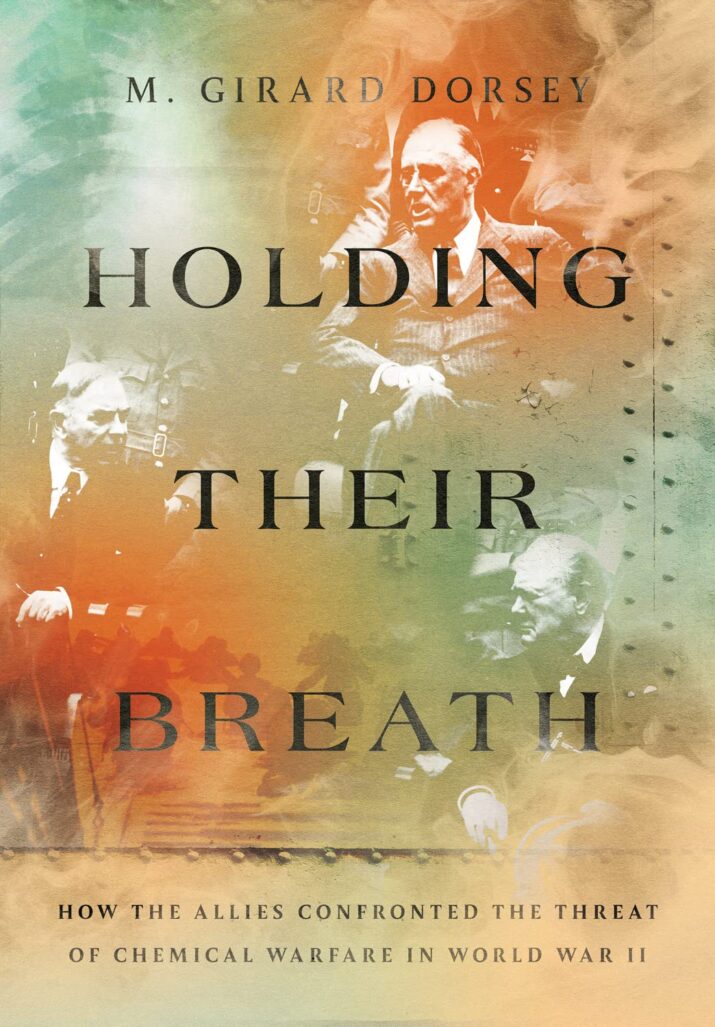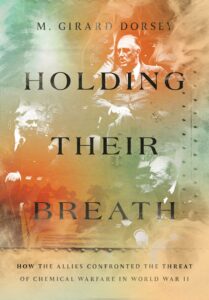
Holding Their Breath: How the Allies Confronted the Threat of Chemical Warfare in World War II by Marion Girard Dorsey

The use of poison gas in war has long been part of the grimier side of World War I history, but it could have been part of World War II as well. Holding Their Breath: How the Allies Confronted the Threat of Chemical Warfare in World War II is a perceptive book that makes clear that the use of chemical weapons was never far below the surface of Western strategy, but restraint proved paramount. The trigger for the use of such weapons was always going to be their use by the enemy. Italy used them against the Ethiopians in 1936 and Japan against the Chinese in the long war in China, but the Axis states knew that the enemy had gas (and biological agents) and were presumably deterred by the risk of retaliation.
In her book, Marion Girard Dorsey begins the story in the 1920s, when fear of a gas attack from the air became a trope in apocalyptic writing about the future of war (though it is the case that two influential air strategists, Billy Mitchell in the United States and Giulio Douhet in Italy, both advocated the use of gas to end a war quickly). The public fears helped to push the major powers to outlaw the use of gas and biological weapons in a Geneva Convention signed in 1925 and ratified by some of the same powers (though not the United States) in the years that followed. From that point on, it was assumed, certainly in Britain, that the potential use of gas against soldiers or civilians was prohibited by international law. The Convention acts as a rather repetitive spine through Dorsey’s history of how the three Atlantic Allies—Britain, Canada, and the United States—came to consider whether or not gas could be used in extremis.
The major part of the book then explores the ways in which the Allies thought about a future gas war and the differences in interpretation of its necessity or possibility. Since the United States did not ratify the Geneva Convention, its forces were not bound by international war in the same way as Britain’s and Canada’s, though Roosevelt made it clear that he respected the spirit of Geneva and agreed with Churchill that the Allies would act only in retaliation, rather than as a first strike. What might justify retaliation was nevertheless a thorny issue. Dorsey is right to argue that the decision to retaliate with gas had to be based on solid knowledge that an Axis enemy was using gas as an approved tactic and that, even in the case of China (where it is now clear that the Japanese did occasionally use gas), there was no hard and fast evidence. There were also problems in preparing for a second strike, in case the enemy got to know about gas stocks, assumed the worst, and initiated a pre-emptive gas war. Dorsey discusses at length the strenuous efforts made by the Western Allies to hide the truth of the disaster at the port of Bari in December 1943, when a German air attack released mustard gas from a damaged ship.
The occasions when the Allies did indeed contemplate the possible use of gas for tactical reasons against enemy armed forces or against the enemy’s cities are reasonably well-known: Churchill contemplated using chemical weapons to slow down a German amphibious assault on southern England in 1940; the British and Americans thought about using gas in the context of the invasion of France in 1944, as gas was seen as possibly reducing casualties and speeding the advance; and perhaps the best known of all occasion was the discussion of using gas in summer 1945 against the Japanese to make it less costly to storm the island strongholds and eventually occupy the Japanese home islands without the high number of predicted casualties. It is nevertheless useful to have these rationales stitched together in a single narrative. More might have been made of the Royal Air Force (RAF) plans in 1943-4 to smother German cities with poison gas at the first sign that the Germans were using it themselves. Stocks of gas bombs were expanded and a list of targets drawn up. If these plans had been carried out, the result would have been horrific, but then so too was the area bombing of German residential zones, which went on from 1942 to the end of the war.
Dorsey focuses a good deal on the troubled discussions between all three Allies—including the Canadians, who seem on this account rather more level-headed than the other two—about the ethical repercussions of crossing the no-use threshold. On the one hand, there seems to have been a general abhorrence at the use of gas but on the other hand a recognition that in some circumstances it would be possible to behave in morally relative ways, so long as it could be justified as necessary. In some ways, this moral concern seems strange since ethical anxieties did not stop the United States from dropping two atomic bombs or from killing 80,000 Japanese in a single night of bombing Tokyo. Gas, or chemical weapons in general, seems to have excited a particular dread, whose origins are not entirely clear.
Dorsey provides a useful summary account of the Western Allies and their thinking about gas warfare, but it is in the end only half the story. For readers, it would have been valuable to learn much more about what the Axis powers were actually doing in terms of preparation for chemical warfare or about how they thought about its strategic or tactical use. The Allies were deeply distrustful of the enemy and expected the worst, which did not happen. Why the Axis states restrained from using chemical weapons needs some exploration. Gas is, of course, a two-edged sword. Using gas on the battlefield could have been dangerous for one’s own troops as well as the enemy’s, moreover, dropping gas on enemy cities would make it likely that the enemy would try to do the same on Allied cities. Yet, the threat of bombing did not elicit a similar deterrent effect—avoiding bombing from fear of enemy retaliation—a paradox that comes back to the question of why gas was feared so much more than other weapons. This paradox suggests that there is room for a broader history of gas in World War II, one that looks at Axis gas policy and at chemical weapons in comparison with other wartime armaments.
Dorsey’s book sets an agenda, but there is more work to be done, not least, as she herself suggests, because chemical warfare remains a twenty-first century threat. The study of chemical weapons warfare certainly raises additional fundamental questions about how effective or not are the treaties and conventions governing the use of what are now termed “weapons of mass destruction.” Gas has been used in Iraq by Saddam Hussein and in Syria more recently by President al-Assad, and in neither case was it possible to use the instruments of international law to penalize those who ordered its use. For major powers, the situation is even more difficult. Putin has not used gas in Ukraine, but his invasion violated the United Nations’ “Nuremberg Principles,” which made aggressive war a crime in international law. However, he is unlikely to face anything more than international disapproval. Dorsey’s account shows that although legal restraint might have been voiced as a motive, in the end there were other motives that restrained the use of chemical weapons in World War II. Does this mean that international agreements on the use of weapons or limits on warfare are pointless? They are certainly not very effective, but at the least they provide a benchmark to measure whether a rogue state today has acted outside the law. Britain and the United States certainly hesitated in World War II to use gas because of the possible reaction of world opinion. But if they had thought that necessity impelled them, they might have risked the opprobrium and gone ahead.
Richard Overy is Honorary Research Professor at the University of Exeter, UK. He is the author of Blood and Ruins: The Last Imperial War (Allen Lane, 2021), for which he won the Society of Military History Distinguished Book Award for 2022. He is a Fellow of the British Academy and a Member of the European Academy for Sciences and Arts.
Holding Their Breath: How the Allies Confronted the Threat of Chemical Warfare in World War II
By M. Girard Dorsey
Publisher: Cornell University Press
Hardcover/ 285 pages / 2023
ISBN 9781501768361
Published on February 15, 2024.




